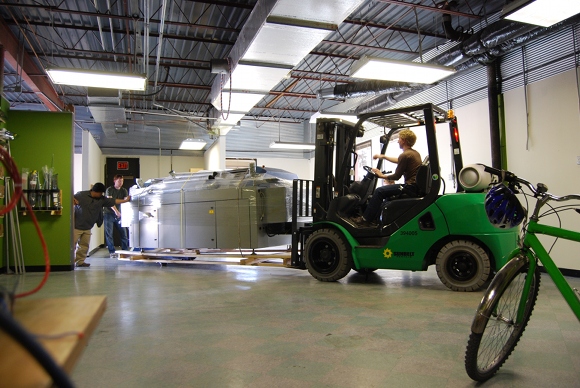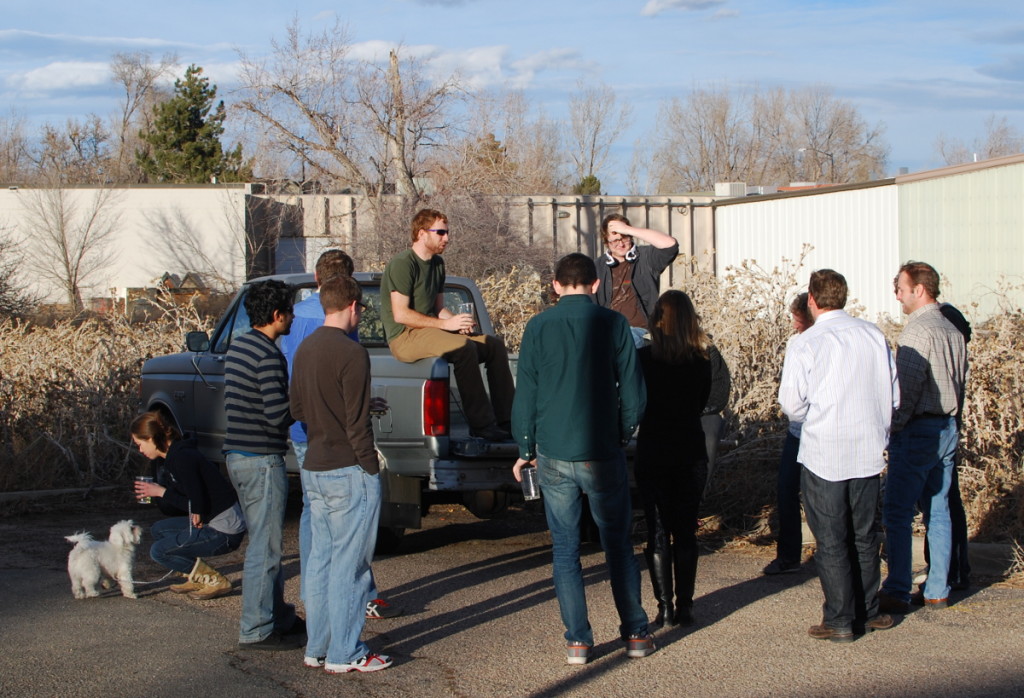 Do you have a kit of Cubelets? Every single Cubelet contains a few tiny circuit boards, and most of these boards have quite a few fiddly little electronic components soldered on top: resistors, capacitors, microcontrollers, etc. If you’re holding a Cubelet in your hands, you might be surprised to know that the bulk of those components were placed onto the board manually, with tweezers, by one of our assembly elves. We’ve manually placed about 30,000 boards worth of components by hand! And that’s crazy, as most visitors to our factory have pointed out. No longer.
We began shopping for a Pick & Place machine this Summer. We’ve spent a lot of time playing electronics with our friends at SparkFun and have been inspired by the creative ways that they manage to manufacture their products here in Boulder, CO. They’re currently making use of three P&P machines: two small Manncorp models and a brand-new fancy Mydata monster that they’ve written about recently. The Mydata machine is pretty incredible, but it’s also $170,000. Yeah. So we bought an $11,000 used Siemens machine that had been sitting in a shuttered factory in Mexico. Yes, we found sand inside.
I’m way too excited about Richard’s current functionality to turn this into a rant about a certain shady industrial equipment dealer. The short version is that the machine, advertised as “tested and working,” needed a few thousand dollars worth of parts, some motor control boards, belts, hoses, all new software, and a few hundred hours worth of tinkering. Four months later, here we are. But look how fast!
Fast indeed. Richard (we named him after our favorite aerobics instructor) is rated at 21,000 components per hour. 2 heads! 12 nozzles on each head! Nozzle garages! I never thought that I’d be so excited by assembly robots.
Do you have a kit of Cubelets? Every single Cubelet contains a few tiny circuit boards, and most of these boards have quite a few fiddly little electronic components soldered on top: resistors, capacitors, microcontrollers, etc. If you’re holding a Cubelet in your hands, you might be surprised to know that the bulk of those components were placed onto the board manually, with tweezers, by one of our assembly elves. We’ve manually placed about 30,000 boards worth of components by hand! And that’s crazy, as most visitors to our factory have pointed out. No longer.
We began shopping for a Pick & Place machine this Summer. We’ve spent a lot of time playing electronics with our friends at SparkFun and have been inspired by the creative ways that they manage to manufacture their products here in Boulder, CO. They’re currently making use of three P&P machines: two small Manncorp models and a brand-new fancy Mydata monster that they’ve written about recently. The Mydata machine is pretty incredible, but it’s also $170,000. Yeah. So we bought an $11,000 used Siemens machine that had been sitting in a shuttered factory in Mexico. Yes, we found sand inside.
I’m way too excited about Richard’s current functionality to turn this into a rant about a certain shady industrial equipment dealer. The short version is that the machine, advertised as “tested and working,” needed a few thousand dollars worth of parts, some motor control boards, belts, hoses, all new software, and a few hundred hours worth of tinkering. Four months later, here we are. But look how fast!
Fast indeed. Richard (we named him after our favorite aerobics instructor) is rated at 21,000 components per hour. 2 heads! 12 nozzles on each head! Nozzle garages! I never thought that I’d be so excited by assembly robots.
O frabjous day! I’m happy to report that Richard Siemens, our 1997 Siplace 80-S20 dual-head, conveyorized Pick & Place machine is fully operational! The significance of this milestone has everything to do with the fact that we bought it in September and have been debugging and repairing it ever since. Here’s us celebrating in our parking lot with a few bottles of Prosecco.
 Do you have a kit of Cubelets? Every single Cubelet contains a few tiny circuit boards, and most of these boards have quite a few fiddly little electronic components soldered on top: resistors, capacitors, microcontrollers, etc. If you’re holding a Cubelet in your hands, you might be surprised to know that the bulk of those components were placed onto the board manually, with tweezers, by one of our assembly elves. We’ve manually placed about 30,000 boards worth of components by hand! And that’s crazy, as most visitors to our factory have pointed out. No longer.
We began shopping for a Pick & Place machine this Summer. We’ve spent a lot of time playing electronics with our friends at SparkFun and have been inspired by the creative ways that they manage to manufacture their products here in Boulder, CO. They’re currently making use of three P&P machines: two small Manncorp models and a brand-new fancy Mydata monster that they’ve written about recently. The Mydata machine is pretty incredible, but it’s also $170,000. Yeah. So we bought an $11,000 used Siemens machine that had been sitting in a shuttered factory in Mexico. Yes, we found sand inside.
I’m way too excited about Richard’s current functionality to turn this into a rant about a certain shady industrial equipment dealer. The short version is that the machine, advertised as “tested and working,” needed a few thousand dollars worth of parts, some motor control boards, belts, hoses, all new software, and a few hundred hours worth of tinkering. Four months later, here we are. But look how fast!
Fast indeed. Richard (we named him after our favorite aerobics instructor) is rated at 21,000 components per hour. 2 heads! 12 nozzles on each head! Nozzle garages! I never thought that I’d be so excited by assembly robots.
Do you have a kit of Cubelets? Every single Cubelet contains a few tiny circuit boards, and most of these boards have quite a few fiddly little electronic components soldered on top: resistors, capacitors, microcontrollers, etc. If you’re holding a Cubelet in your hands, you might be surprised to know that the bulk of those components were placed onto the board manually, with tweezers, by one of our assembly elves. We’ve manually placed about 30,000 boards worth of components by hand! And that’s crazy, as most visitors to our factory have pointed out. No longer.
We began shopping for a Pick & Place machine this Summer. We’ve spent a lot of time playing electronics with our friends at SparkFun and have been inspired by the creative ways that they manage to manufacture their products here in Boulder, CO. They’re currently making use of three P&P machines: two small Manncorp models and a brand-new fancy Mydata monster that they’ve written about recently. The Mydata machine is pretty incredible, but it’s also $170,000. Yeah. So we bought an $11,000 used Siemens machine that had been sitting in a shuttered factory in Mexico. Yes, we found sand inside.
I’m way too excited about Richard’s current functionality to turn this into a rant about a certain shady industrial equipment dealer. The short version is that the machine, advertised as “tested and working,” needed a few thousand dollars worth of parts, some motor control boards, belts, hoses, all new software, and a few hundred hours worth of tinkering. Four months later, here we are. But look how fast!
Fast indeed. Richard (we named him after our favorite aerobics instructor) is rated at 21,000 components per hour. 2 heads! 12 nozzles on each head! Nozzle garages! I never thought that I’d be so excited by assembly robots.
 Do you have a kit of Cubelets? Every single Cubelet contains a few tiny circuit boards, and most of these boards have quite a few fiddly little electronic components soldered on top: resistors, capacitors, microcontrollers, etc. If you’re holding a Cubelet in your hands, you might be surprised to know that the bulk of those components were placed onto the board manually, with tweezers, by one of our assembly elves. We’ve manually placed about 30,000 boards worth of components by hand! And that’s crazy, as most visitors to our factory have pointed out. No longer.
We began shopping for a Pick & Place machine this Summer. We’ve spent a lot of time playing electronics with our friends at SparkFun and have been inspired by the creative ways that they manage to manufacture their products here in Boulder, CO. They’re currently making use of three P&P machines: two small Manncorp models and a brand-new fancy Mydata monster that they’ve written about recently. The Mydata machine is pretty incredible, but it’s also $170,000. Yeah. So we bought an $11,000 used Siemens machine that had been sitting in a shuttered factory in Mexico. Yes, we found sand inside.
I’m way too excited about Richard’s current functionality to turn this into a rant about a certain shady industrial equipment dealer. The short version is that the machine, advertised as “tested and working,” needed a few thousand dollars worth of parts, some motor control boards, belts, hoses, all new software, and a few hundred hours worth of tinkering. Four months later, here we are. But look how fast!
Fast indeed. Richard (we named him after our favorite aerobics instructor) is rated at 21,000 components per hour. 2 heads! 12 nozzles on each head! Nozzle garages! I never thought that I’d be so excited by assembly robots.
Do you have a kit of Cubelets? Every single Cubelet contains a few tiny circuit boards, and most of these boards have quite a few fiddly little electronic components soldered on top: resistors, capacitors, microcontrollers, etc. If you’re holding a Cubelet in your hands, you might be surprised to know that the bulk of those components were placed onto the board manually, with tweezers, by one of our assembly elves. We’ve manually placed about 30,000 boards worth of components by hand! And that’s crazy, as most visitors to our factory have pointed out. No longer.
We began shopping for a Pick & Place machine this Summer. We’ve spent a lot of time playing electronics with our friends at SparkFun and have been inspired by the creative ways that they manage to manufacture their products here in Boulder, CO. They’re currently making use of three P&P machines: two small Manncorp models and a brand-new fancy Mydata monster that they’ve written about recently. The Mydata machine is pretty incredible, but it’s also $170,000. Yeah. So we bought an $11,000 used Siemens machine that had been sitting in a shuttered factory in Mexico. Yes, we found sand inside.
I’m way too excited about Richard’s current functionality to turn this into a rant about a certain shady industrial equipment dealer. The short version is that the machine, advertised as “tested and working,” needed a few thousand dollars worth of parts, some motor control boards, belts, hoses, all new software, and a few hundred hours worth of tinkering. Four months later, here we are. But look how fast!
Fast indeed. Richard (we named him after our favorite aerobics instructor) is rated at 21,000 components per hour. 2 heads! 12 nozzles on each head! Nozzle garages! I never thought that I’d be so excited by assembly robots. 

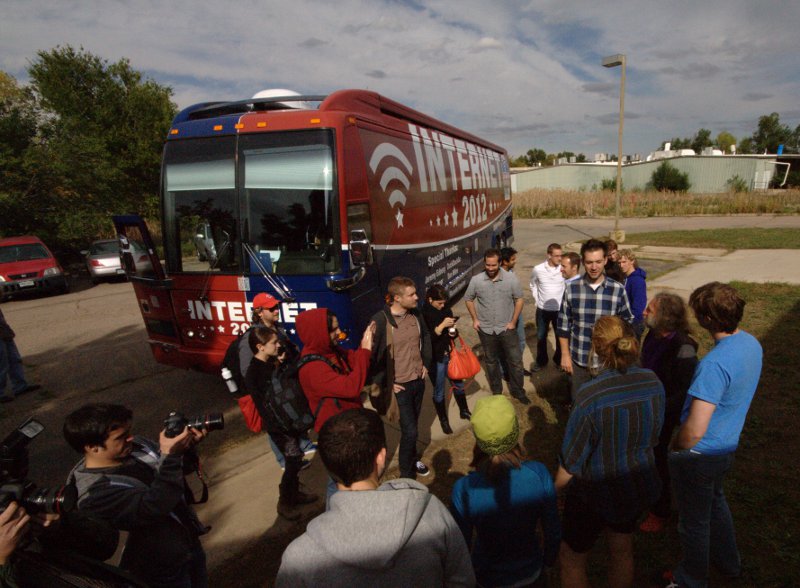 Big day at Modular Robotics yesterday. We were scrambling to make some last minute preparations for the evening’s
Big day at Modular Robotics yesterday. We were scrambling to make some last minute preparations for the evening’s 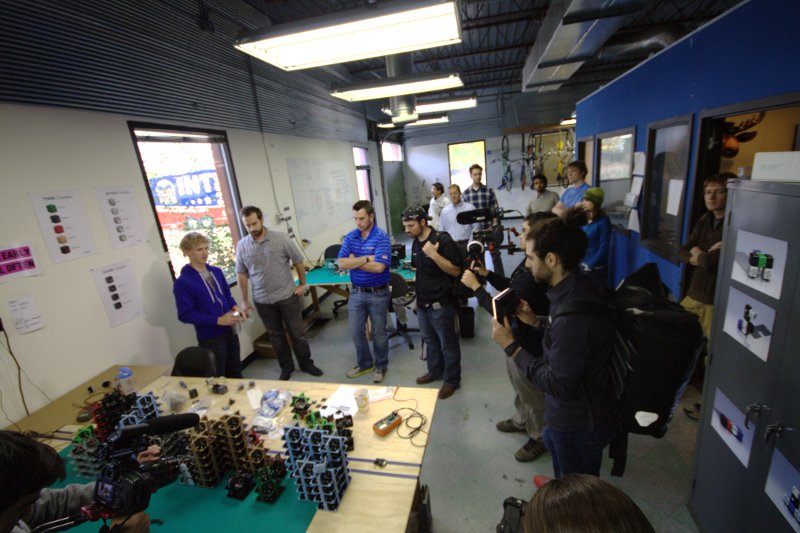 We played with Cubelets, walked around our factory, and talked a little about how crazy it is to think about manufacturing consumer electronics in the USA these days. We ate little cheese Cubelets, drank coconut water, and had some fun with the
We played with Cubelets, walked around our factory, and talked a little about how crazy it is to think about manufacturing consumer electronics in the USA these days. We ate little cheese Cubelets, drank coconut water, and had some fun with the  Why did the bus decide to stop at Modular Robotics? It turns out that they just asked around for the coolest company in town and found us. Awesome. But there’s a deeper synergy at work here that might not be apparent at first glance.
Cubelets are the building blocks of intelligent systems. But we’re taking a huge departure from the way the field of artificial intelligence has worked for the last 60 years. Normal artificial intelligence is “top down.” We write programs for robots telling them to do one thing, then another, then wait for something, etc. Instead of writing a big fat complicated program for a robot, Cubelets are “bottom up”. Their behavior emerges from lots of little simple robots each doing their own thing. The magic happens when they all get together and we see things like steering or intentional-looking behaviors like wall avoidance or alarm-sounding just sort of happen.
This is kind of how the Internet works too: it’s a tremendously huge system that relies on many, many users and devices and programs to run, and it gives rise to all sorts of higher-level emergent elements (like bullying or social networking or
Why did the bus decide to stop at Modular Robotics? It turns out that they just asked around for the coolest company in town and found us. Awesome. But there’s a deeper synergy at work here that might not be apparent at first glance.
Cubelets are the building blocks of intelligent systems. But we’re taking a huge departure from the way the field of artificial intelligence has worked for the last 60 years. Normal artificial intelligence is “top down.” We write programs for robots telling them to do one thing, then another, then wait for something, etc. Instead of writing a big fat complicated program for a robot, Cubelets are “bottom up”. Their behavior emerges from lots of little simple robots each doing their own thing. The magic happens when they all get together and we see things like steering or intentional-looking behaviors like wall avoidance or alarm-sounding just sort of happen.
This is kind of how the Internet works too: it’s a tremendously huge system that relies on many, many users and devices and programs to run, and it gives rise to all sorts of higher-level emergent elements (like bullying or social networking or 
 Credits: Jon Hiller took these great photos. Thanks Jon!
Credits: Jon Hiller took these great photos. Thanks Jon! 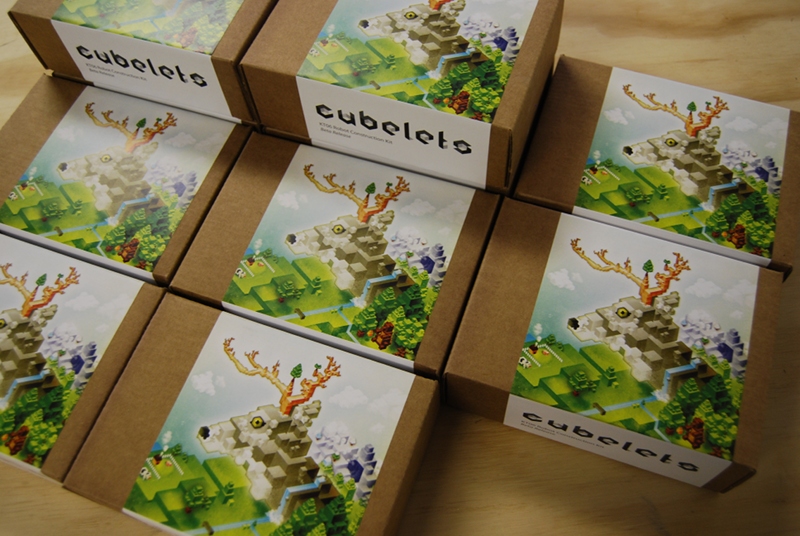 I’m happy to report that we’re busy assembling Cubelets and are finally shipping again. These are the new KT06 boxes! We’ve got a lot of pre-orders to work through — if you have a pending pre-order, expect an email in the next day or two with a new estimated shipping date.
I’m happy to report that we’re busy assembling Cubelets and are finally shipping again. These are the new KT06 boxes! We’ve got a lot of pre-orders to work through — if you have a pending pre-order, expect an email in the next day or two with a new estimated shipping date. 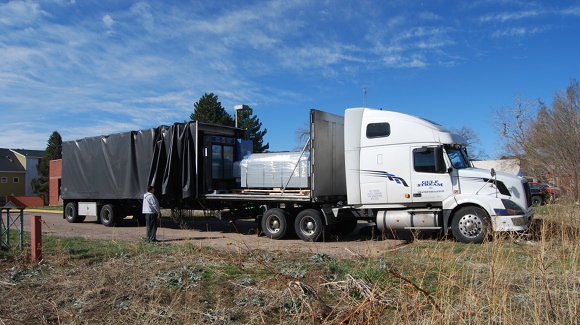 We rented a forklift for the day to lift our new twelve foot long reflow oven off the truck and bring it into our shop. Matt drove.
We rented a forklift for the day to lift our new twelve foot long reflow oven off the truck and bring it into our shop. Matt drove.
 This beauty is an Electrovert Omniflo 5. We bought it used from a broker in Washington. It’s got 5 heating zones and is programmed with specific temperature curves to solder our Cubelets boards perfectly. Since the old skillet method worked so well, we weren’t really sure that we were going to need a real reflow oven, but it turned out that the boards that got burned or a little undercooked had a nefarious way of making their way further down the assembly process and requiring a lot of time to fix later. So we’re reflowing. 480 PCBs so far and they’re all beautiful! I never thought I’d be so excited about a piece of industrial equipment.
This beauty is an Electrovert Omniflo 5. We bought it used from a broker in Washington. It’s got 5 heating zones and is programmed with specific temperature curves to solder our Cubelets boards perfectly. Since the old skillet method worked so well, we weren’t really sure that we were going to need a real reflow oven, but it turned out that the boards that got burned or a little undercooked had a nefarious way of making their way further down the assembly process and requiring a lot of time to fix later. So we’re reflowing. 480 PCBs so far and they’re all beautiful! I never thought I’d be so excited about a piece of industrial equipment.
